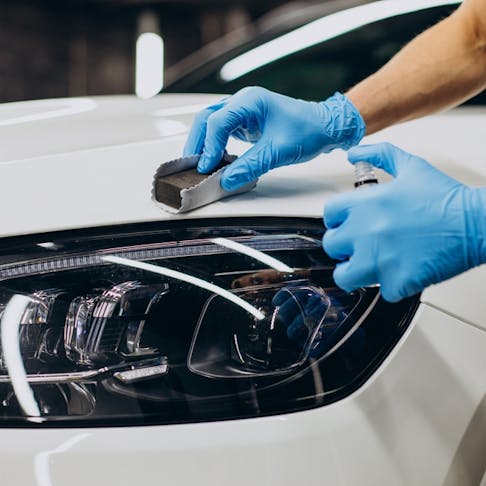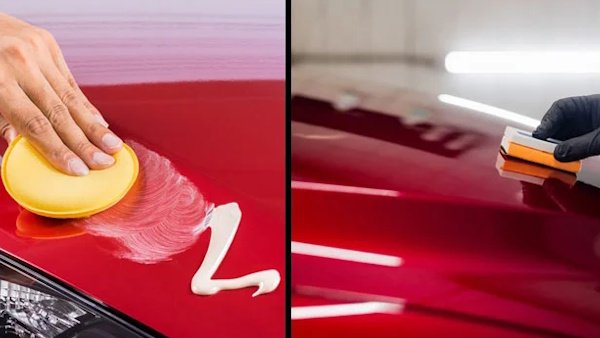Seven maintenance tips to make Ceramic Coating Newark last longer
Wiki Article
Discovering the Scientific Research Behind Car Ceramic Coating and Its Protective Characteristics
The science of car ceramic coating offers a fascinating research study in sophisticated auto security. Composed mainly of silicon dioxide and polymers, these finishings create a robust bond with vehicle paint. This communication boosts toughness versus ecological threats while supplying hydrophobic advantages. The details of just how these finishings job and their lasting advantages stay less understood. Ceramic Coating Newark. Unloading these details exposes why ceramic finishings are ending up being a preferred option for automobile treatmentWhat Is Ceramic Coating?
Ceramic coating is a liquid polymer that chemically bonds to the surface of a vehicle's paint. This sophisticated safety layer improves resilience and uses exceptional resistance to environmental elements. Unlike conventional wax or sealants, which provide short-term defense, ceramic finishes produce a resilient guard that can stand up to extreme problems such as UV rays, acidic pollutants, and extreme weather. When applied correctly, the coating forms a hydrophobic surface area, creating water to grain and slide off, which helps in keeping the car's sanitation. Furthermore, it offers enhanced gloss and depth to the paint, making the automobile appear even more polished and vivid. The application process typically entails extensive surface prep work, consisting of cleaning and polishing, to guarantee peak bonding. Therefore, ceramic coverings are coming to be progressively popular amongst car enthusiasts and those looking for to shield their investments, promising to maintain the lorry's visual charm while lowering the frequency of upkeep.The Composition of Ceramic Coatings
The detailed solution of ceramic finishes largely consists of silicon dioxide (SiO2), which is acquired from all-natural sources like quartz and sand. This vital component provides the foundation for the coating's sturdiness and safety top qualities. In enhancement to SiO2, ceramic finishings usually include various polymers and additives that enhance bond, adaptability, and resistance to ecological factors. These compounds function synergistically to develop a robust barrier against impurities such as dust, chemicals, and UV rays.Furthermore, some solutions incorporate titanium dioxide (TiO2) or various other nanomaterials, which can increase the coating's hydrophobic buildings, causing improved water repellency. The exact make-up can vary substantially amongst suppliers, affecting performance and long life. Eventually, the mix of these components finishes in a protective layer that not only improves the visual allure of vehicles but likewise serves to prolong their lifespan by protecting the surface area from possible damage.How Ceramic Coatings Work
Understanding exactly how ceramic finishes function entails discovering their chemical structure, which adds to their protective qualities. The application process is crucial for attaining perfect results, while long life and longevity variables determine the coating's effectiveness with time. With each other, these elements highlight the advantages and performance of ceramic finishings for car defense.Chemical Structure Explained
While numerous car proprietors look for long-lasting protection for their lorries, the chemical composition of ceramic coverings plays an important role in their effectiveness. These layers mostly consist of silicon dioxide (SiO2), which is stemmed from natural minerals. This compound forms a solid bond with the vehicle's paint, developing a durable, protective layer. Additionally, several ceramic layers contain titanium dioxide (TiO2), boosting their hydrophobic properties and resistance to UV rays. The existence of polysiloxanes can additionally boost versatility and longevity. With each other, these components add to the coating's capacity to drive away water, dust, and impurities, while likewise giving a high-gloss coating. Understanding this chemical foundation assists car proprietors appreciate the durable defense offered by ceramic finishings.Application Refine Summary
Applying ceramic coverings involves a precise process that assures optimal bonding and protection for the car's surface. Originally, complete cleansing and purification of the car's exterior are carried out to get rid of dirt, crud, and previous waxes. This step validates that the surface area is without impurities that might prevent adhesion. Following this, the paint is usually polished to enhance clarity and get rid of any kind of flaws. As soon as prepared, the ceramic coating is used in little areas utilizing an applicator pad, permitting for uniform coverage. The coating is after that delegated heal, creating a strong chemical bond with the surface. Appropriate treating times and problems are important, as they validate the coating achieves its maximum effectiveness and safety qualities.Durability and Resilience Elements
Ceramic finishings are made to offer lasting defense through their sophisticated chemical make-up, which develops a robust obstacle against ecological contaminants. The sturdiness of these layers is influenced by variables such as the density of the application, the high quality of the item, and the conditions under which the vehicle is subjected. Top quality ceramic layers can last a number of years, withstanding scratches, UV rays, and chemical spots. Appropriate maintenance, consisting of normal washing and regular reapplication, can even more improve long life. Furthermore, environmental factors like climate and direct exposure to pollutants can influence the life-span of the coating. Generally, when used and preserved properly, ceramic finishes provide phenomenal resilience, making them a prominent option for car lovers looking for to protect their car's look.Hydrophobic Properties and Water Repellency
Hydrophobic residential or commercial properties are a characteristic of quality car ceramic layers, substantially boosting the automobile's surface efficiency. These finishes develop a molecular bond with the car's paint, causing a surface that fends off water effectively. When water comes right into call with a ceramic-coated surface, it grains up and rolls off, decreasing the quantity of liquid that continues to be on the paint. This navigate to this site actions not just adds to a visually pleasing appearance however additionally decreases the build-up of pollutants such as dirt, grime, and roadway salts.The improved water repellency causes much easier cleaning and maintenance, as less effort is required to get rid of undesirable substances. Furthermore, the hydrophobic nature of ceramic finishings helps in preventing water places, which can mar the surface of uncoated surface areas. Overall, the unification of hydrophobic residential properties in ceramic finishings plays a necessary function in preserving the automobile's immaculate appearance while streamlining upkeep.Protection Against Scratches and UV Damages
Car ceramic finishes offer considerable protection versus scrapes and UV damage. The scrape resistance system creates a long lasting layer that soaks up impacts, while the UV securing advantages help maintain the car's paint honesty with time. Together, these features add to a longer-lasting and aesthetically enticing finish.Scrape Resistance Mechanism
Utilizing sophisticated technology, ceramic layers provide a robust shield versus scrapes and UV damage, boosting the long life and appearance of automobile surface areas. The scrape resistance system of these coatings is connected to their special molecular framework, which creates a durable bond with the car's paint. This bond produces a hard, safety layer that can soak up influences and withstand abrasions. Furthermore, the smooth surface area of the coating lowers friction, making it tough for pollutants to adhere and create scratches. The chemical composition of ceramic finishings often consists of nanoparticles that strengthen the protective layer, more improving its durability. Automobiles treated with ceramic layers show considerably enhanced scrape resistance contrasted to typical wax or sealants, making sure a beautiful finish over time.UV Shielding Conveniences
The safety top qualities of ceramic coverings prolong beyond scrape resistance to consist of substantial UV shielding benefits. These coverings produce a robust obstacle that shows damaging ultraviolet rays, protecting the vehicle's paint and underlying materials. Long term direct exposure to UV radiation can cause fading, oxidation, and deterioration of the paint coating. By integrating ceramic coatings, car proprietors can effectively alleviate these threats, preserving the aesthetic appeal and honesty of their vehicles. Additionally, the UV blocking homes add to boosted longevity, lowering the frequency of repainting and upkeep. Ultimately, the integration of ceramic finishes uses a complete solution for shielding lorries from the damaging effects of sunlight direct exposure, ensuring a sustained, lively look in time.The Durability and Upkeep of Ceramic Coatings

Regularly Asked Questions
Can Ceramic Coating Be Applied to Any Type Of Kind of Vehicle?
Ceramic coating can be applied to different types of cars, consisting of autos, vehicles, and bikes. Nonetheless, surface area prep work and compatibility with certain products are crucial for excellent attachment and effectiveness of the coating.Just How Much Does Ceramic Coating Normally Cost?
Ceramic coating commonly costs between $500 and $2,000, depending on aspects such as car size, coating quality, and expert application. The investment can supply long-lasting security and improve the car's look over time.
Is Professional Application Needed for Best Results?
The requirement of specialist application typically depends on desired results. Professionals typically ensure appropriate surface area preparation and application strategies, causing excellent bonding and durability of the coating, which may be challenging for inexperienced people to attain.Can Ceramic Coatings Be Eliminated or Fixed?
Ceramic coatings can be gotten rid of or fixed, though the process may need specific solvents or strategies - Ceramic Coating Newark. Proper removal is necessary to stay clear of damage to the underlying surface, emphasizing the importance of specialist help for ideal resultsExactly How Does Porcelain Coating Contrast to Typical Wax?
The comparison in between ceramic coating and typical wax reveals that ceramic layers supply premium longevity, boosted defense against environmental contaminants, and longer-lasting shine, while wax needs extra constant application and supplies much less total resistance to damage.Report this wiki page